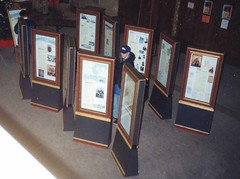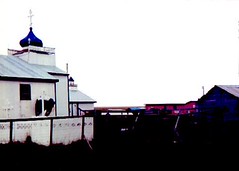The following is reprinted with permission from the Kodiak Daily Mirror (thank you) and on-line at
Alaskan author, researcher Lydia Black dies at age 81
Article published on Monday, March 12th, 2007, By SCOTT CHRISTIANSEN, Kodiak Daily MirrorDr. Lydia Black, noted anthropologist and author of several books on Alaska Native culture and Alaska history, died this morning at the age of 81 at her home in Kodiak. Black was with family and friends at the time of her death. She died of liver failure and had been ill several months.
Black was well known around the state. Her daughter, Zoë Pierson, said frequent visitors from Kodiak and around Alaska had assisted the family in caring for Black during recent weeks.
“She loved people, so when visitors were in she would visit with them and talk with them if she was awake,” Pierson said this morning.
Black was born in Kiev, Ukraine, of the then-Soviet Union, and educated in Russia, Germany and the United States. She had five daughters with her husband, Igor A. Black, a thermodynamics engineer who worked for NASA contractors during the 1960s, and preceded his wife in death in 1969.
As a young widow, Black became a professor of anthropology, beginning in 1973 at Providence College in Providence, R.I. In 1984 she came to Alaska permanently and began teaching at the University of Alaska Fairbanks.
Throughout her career, Black traveled Southwest Alaska to research the culture and traditions of the region. She became known as the preeminent scholar of the Unangam (Aleut) of the Aleutian Islands and the Sugpiaq (Alutiiq) of the Kodiak Archipelago.
Fluent in Slavonic and Russian, Black translated many firsthand accounts of Native cultures written during the Russian colonial period.
In her writings, Black was known for emphasizing artistic and cultural accomplishments, rather than social ills of Alaska Native cultures.
“They know they have problems. My job is to remind them of their glory,” is what Black reportedly said of her work.
Family members and colleagues said Black was unapologetic for describing Alaska Native history from that perspective.
“That was the way she felt and she would tell you so if it came up,” Pierson said.
Black retired from UAF in 1998, and continued her work in Kodiak, where she helped translate and catalogue Russian archives of St. Herman’s Seminary. The Orthodox Church in Alaska recognized her contribution by awarding her the Cross of St. Herman.
Black continued to write and edit. Some of her most accessible work was published following her retirement.
One of her best-known books, “Aleut art — Unangam aguqaadangin” is a collection of beautifully photographed and carefully documented art made by Natives of the Aleutian Islands. Another, “Russians in Alaska, 1732 to 1867,” was published in 2004, the year Black turned 79.
Black was also known for continuing correspondence and cultivating friendships with many of her students, even after their professional careers began and after she had retired from teaching.
Katherine Arndt, a close friend and colleague who works in the archives at the Elmer E. Rasmuson Library at UAF, had a professional relationship with Black that blossomed into a friendship. Arndt said her own doctorate in Anthropology is the result of returning to studies at Black’s urging.
“If you know her at all, you would know that once you are her student, you would remain her student for life,” Arndt said.
In 2001, the Soviet successor state, now called the Russian Federation, awarded Black the Order of Friendship in recognition of her work documenting the Russian America colonial period.
As with her work involving Alaska Native culture, Black’s writing about Russian colonists in Alaska often confronted commonly held misconceptions head-on, and was meant to be accessible by the layperson.
“She wanted the general public to know that the Russians weren’t brutal, cruel and drunk all of the time,” Arndt said.
Pierson said that during her mother’s final days, Black was able to visit with many of the people who came to care for and visit with her.
Black remained a teacher, even while gravely ill.
“She was a born teacher, so anyone who asked for information, they would get that and more.”
A funeral service for Black is noon on Saturday, March 17, at St. Paul Lutheran Church, with a burial to follow at City Cemetery. A reception is scheduled for 4 p.m., March 17, at the Kodiak Senior Center.
Mirror writer Scott Christiansen can be reached via e-mail at schristiansen AT kodiakdailymirror DOT com.
Site Search Tags: Kodiak, Lydia+Black, Orthodox, Alaska, Russian+America
















 Prof. Lydia Black, Ph.D. at the conference
Prof. Lydia Black, Ph.D. at the conference


 Stable carbon isotopes do not date but nevertheless lead full lives. mpb
Stable carbon isotopes do not date but nevertheless lead full lives. mpb FeedBurner
FeedBurner Grassroots science
Grassroots science LinkedIn Profile
LinkedIn Profile Read by E-mail
Read by E-mail Small Island Developing States Network
Small Island Developing States Network